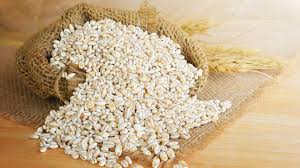What are the Different Types of Barley?
Barley is a remarkable grain that has been a staple in human diets for thousands of years, and we have different types of barley. Its journey from field to table is a tale of resilience and adaptability, making it a crucial part of various cuisines and agricultural practices worldwide.
In fields, barley stands tall, swaying gently with the wind. Its slender green stalks bear golden grains, creating a picturesque sight in vast agricultural landscapes. Farmers have cultivated barley for its versatility; it can thrive in diverse climates, from the cool highlands to the warm plains.
When harvested, barley undergoes a series of transformations to reach our plates. The grains are carefully separated from the stalks and then processed into different forms, such as barley flour, pearl barley, and barley flakes. Each variant brings its unique texture and flavor to culinary creations.
One of the most notable uses of barley is in brewing. Malted barley serves as a key ingredient in beer production, contributing both sweetness and body to the beverage. The malting process involves germinating and drying the barley, unlocking enzymes that convert starches into sugars. This alchemical transformation is at the heart of brewing, giving beer its distinct taste and character.
Beyond brewing, barley plays a crucial role in the culinary world. Pearl barley, for instance, is a versatile grain used in soups, stews, and salads. Its chewy texture adds a delightful element to dishes, while its mild flavor allows it to complement a wide range of ingredients. Barley’s nutritional profile is impressive, boasting high fiber content, essential vitamins, and minerals that contribute to a healthy diet.
Barley’s journey doesn’t end with food and drink; it extends to animal feed and even contributes to the production of malt extracts and syrups. This multi-faceted grain has found its way into various aspects of human life, embodying the spirit of adaptability and utility.
In addition to its practical applications, barley has cultural significance in many societies. It has been a symbol of prosperity, fertility, and hospitality in different cultures throughout history. Ancient civilizations revered barley for its role in sustaining life and providing nourishment.
As we reflect on the journey of barley from the fields to our tables, it’s evident that this humble grain is more than just a food item—it’s a symbol of resilience, adaptability, and the interdependence between nature and human civilization. Barley’s enduring presence in our lives is a testament to its importance and the integral role it plays in our global food culture.
Read Also: Achatina Achatina Specie of Snail: All you need to know about
What are the Different Types of Barley

Barley comes in various types, each with its own unique characteristics and uses. Two primary types of barley are commonly cultivated: hulled barley and hull-less barley.
1. Hulled Barley: Hulled barley, also known as whole barley, retains its outer husk, bran, and germ. This type of barley is minimally processed, making it a more nutritionally dense option. Hulled barley takes longer to cook due to its intact bran layer, but it offers a chewy texture and a nutty flavor. It is often used in salads, soups, and pilafs.
2. Hull-less Barley: Hull-less barley has had its tough outer hull removed, simplifying the milling process. This type of barley cooks more quickly than hulled barley and has a softer texture. Hull-less barley still contains the bran and germ, providing a good balance of flavor and nutrition. It is commonly used in baking, as a side dish, or as a breakfast grain.
These main types of barley further branch out into varieties such as barley flakes, barley flour, and pearl barley, each adapted for specific culinary applications. Pearl barley, for instance, undergoes a process that removes the outer bran layer, resulting in a smoother texture and shorter cooking time. This makes it a popular choice for soups, stews, and risottos.
Barley’s diversity extends to its use in malting for brewing purposes. Two-row barley and six-row barley are distinctions based on the arrangement of grains on the barley head. Two-row barley is often preferred for brewing due to its larger grains and higher enzyme content, contributing to a smoother beer flavor.
In essence, the various types of barley cater to different preferences and culinary needs, ensuring that this versatile grain remains a staple in a wide array of dishes around the world. Whether you seek the robust texture of hulled barley or the convenience of pearl barley, there’s a barley variety to suit every taste and culinary occasion.
Beyond hulled and hull-less barley, several other types and varieties add to the diversity of this versatile grain.
3. Barley Flakes: Barley flakes are produced by steaming, rolling, and drying hulled barley. These flattened grains cook quickly and are commonly used in breakfast cereals, granola bars, and as an ingredient in baking.
4. Barley Flour: Barley flour is a finely ground powder made from barley grains. It offers a nutty flavor and can be used in baking, particularly for bread, muffins, and pancakes. Barley flour adds a unique taste and nutritional profile to various recipes.
5. Pot Barley: Pot barley is a partially pearled barley variety, meaning it has undergone minimal processing, leaving some of the bran intact. It strikes a balance between the nutritional density of hulled barley and the quicker cooking time of pearl barley. Pot barley is often used in hearty stews and casseroles.
6. Naked Barley: Naked barley varieties have a loose hull that easily falls off during harvesting, simplifying the milling process. This type of barley retains more of its bran and germ, offering a wholesome and nutritious option. Naked barley is used in a variety of dishes, from salads to pilafs.
7. Black Barley: Black barley, also known as purple barley, is a less common variety with a distinctive dark color. It has a slightly sweet, earthy flavor and retains its shape well during cooking. Black barley is often used for salads, side dishes, or as a visually striking addition to various recipes.
8. Six-Row Barley: Six-row barley is a type that has six rows of grains on its head, as opposed to the two rows found in two-row barley. It is often utilized in animal feed due to its higher protein content. While not as commonly used for brewing beer as two-row barley, six-row barley has its applications in agriculture.
These diverse types of barley showcase the adaptability of this grain in various culinary settings, from breakfast options to hearty meals and even brewing. Whether you’re looking for a quick-cooking option like barley flakes or a specialty variety like black barley for a unique twist, barley offers a range of choices to suit different tastes and preferences.
Read Also: Suitable Tropical Snail Species for Farming
How to Grow Barley (Growing Guide)

Growing barley is a rewarding process that involves several key steps. Here’s a simplified guide on how to grow barley:
1. Selecting the Right Variety: Choose a barley variety that suits your climate and intended use. Barley is adaptable, but different varieties thrive in specific conditions. Common types include two-row and six-row barley.
2. Soil Preparation: Barley prefers well-draining soil with a slightly acidic to neutral pH. Prepare the soil by removing weeds and incorporating organic matter. Barley is relatively tolerant, but optimal soil conditions contribute to better growth.
3. Planting: Plant barley seeds directly in the soil in early spring or late fall, depending on your location. Sow the seeds at a depth of about one to two inches, spaced according to the specific recommendations for the chosen barley variety.
4. Watering: Barley requires consistent moisture, especially during the germination and flowering stages. Adequate watering is crucial, but be cautious not to water excessively, as barley is susceptible to waterlogged conditions.
5. Fertilizing: Apply a balanced fertilizer before planting or during the early growth stages. Barley generally doesn’t have excessive nutrient requirements, but a well-balanced soil helps support healthy growth.
6. Managing Weeds: Keep the barley field free from weeds, especially during the initial stages of growth. Weeds can compete with barley for nutrients and water, affecting overall yield.
7. Disease and Pest Management: Monitor the crop for signs of diseases or pests. Barley can be susceptible to certain fungal diseases and insects. Use appropriate treatments if necessary, and consider planting disease-resistant barley varieties.
8. Harvesting: Barley is ready for harvest when the grains have reached full maturity and the stalks have turned yellow. Harvesting is typically done with a combine harvester, cutting the stalks and separating the grains.
9. Drying and Storage: After harvesting, dry the barley to reduce moisture content. Properly dried barley can be stored in cool, dry conditions. Ensure that the storage facility is well-ventilated to prevent mold or moisture-related issues.
10. Rotation and Crop Management: Practice crop rotation to prevent soil-borne diseases and maintain soil fertility. Barley is often used in rotation with other crops for a sustainable farming approach.
Remember, local climate and soil conditions can influence the specific practices for growing barley. Consulting with local agricultural extension services or experienced farmers in your area can provide valuable insights tailored to your specific location and conditions.
Read Also: Basic Importance of Advertising









